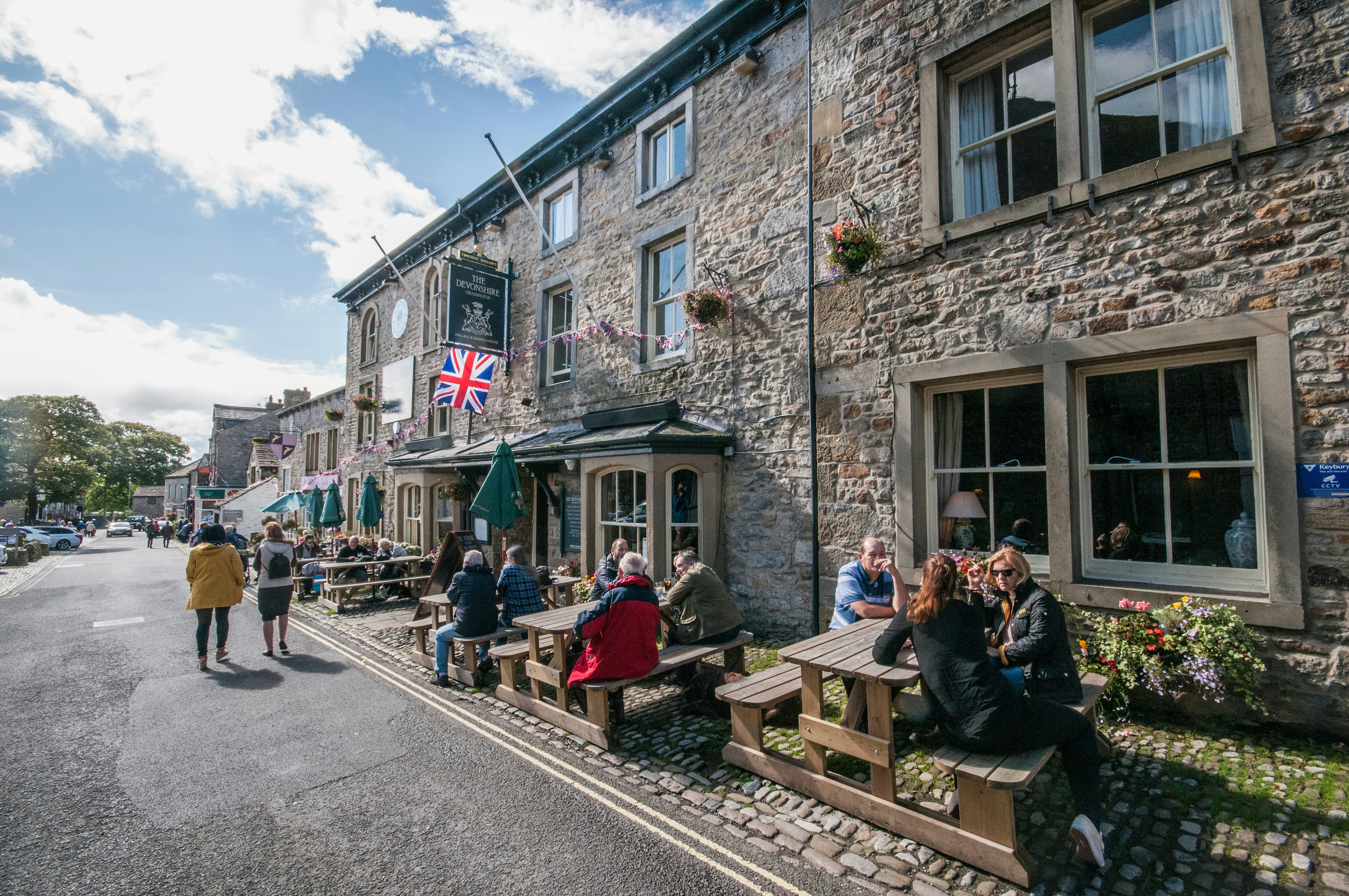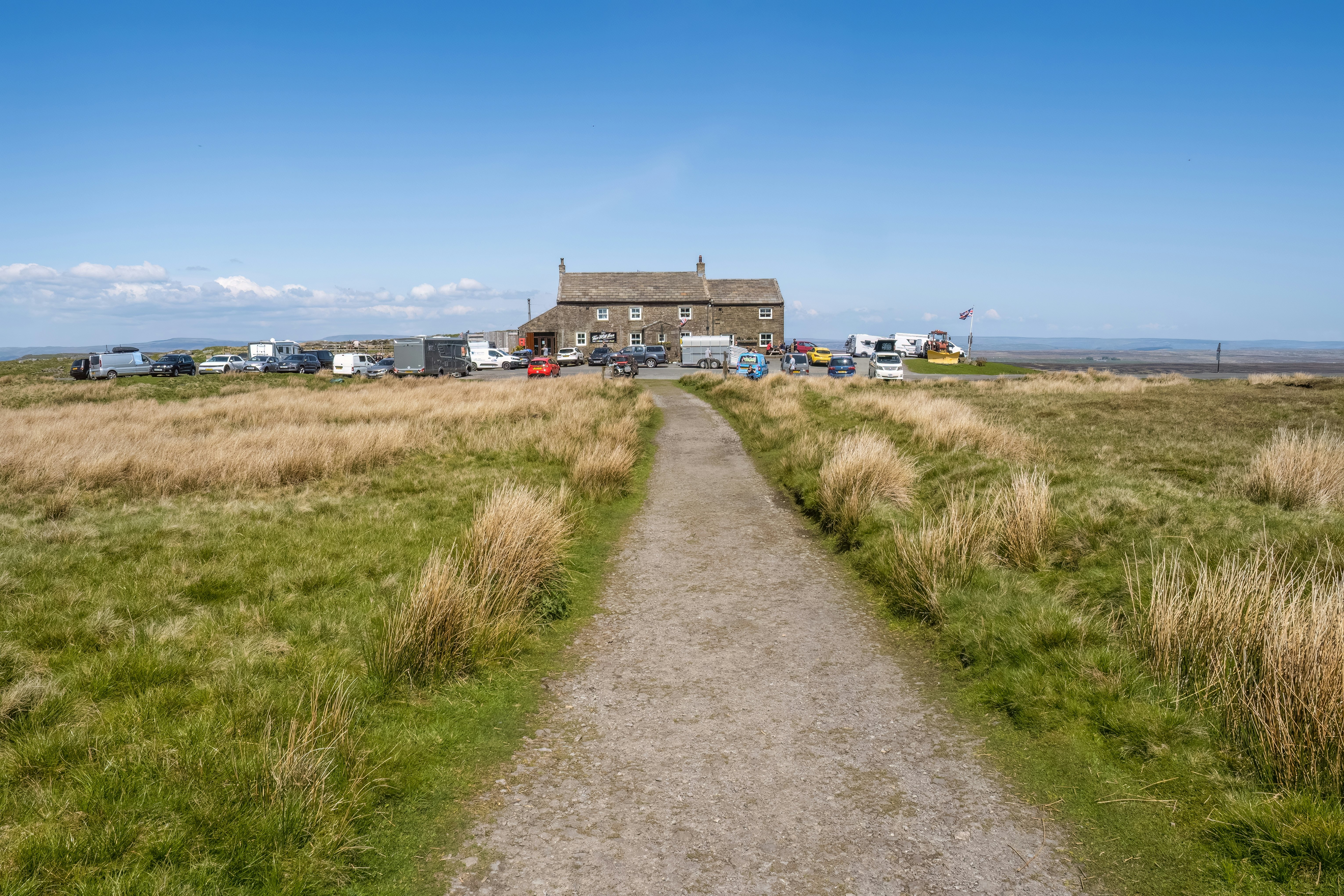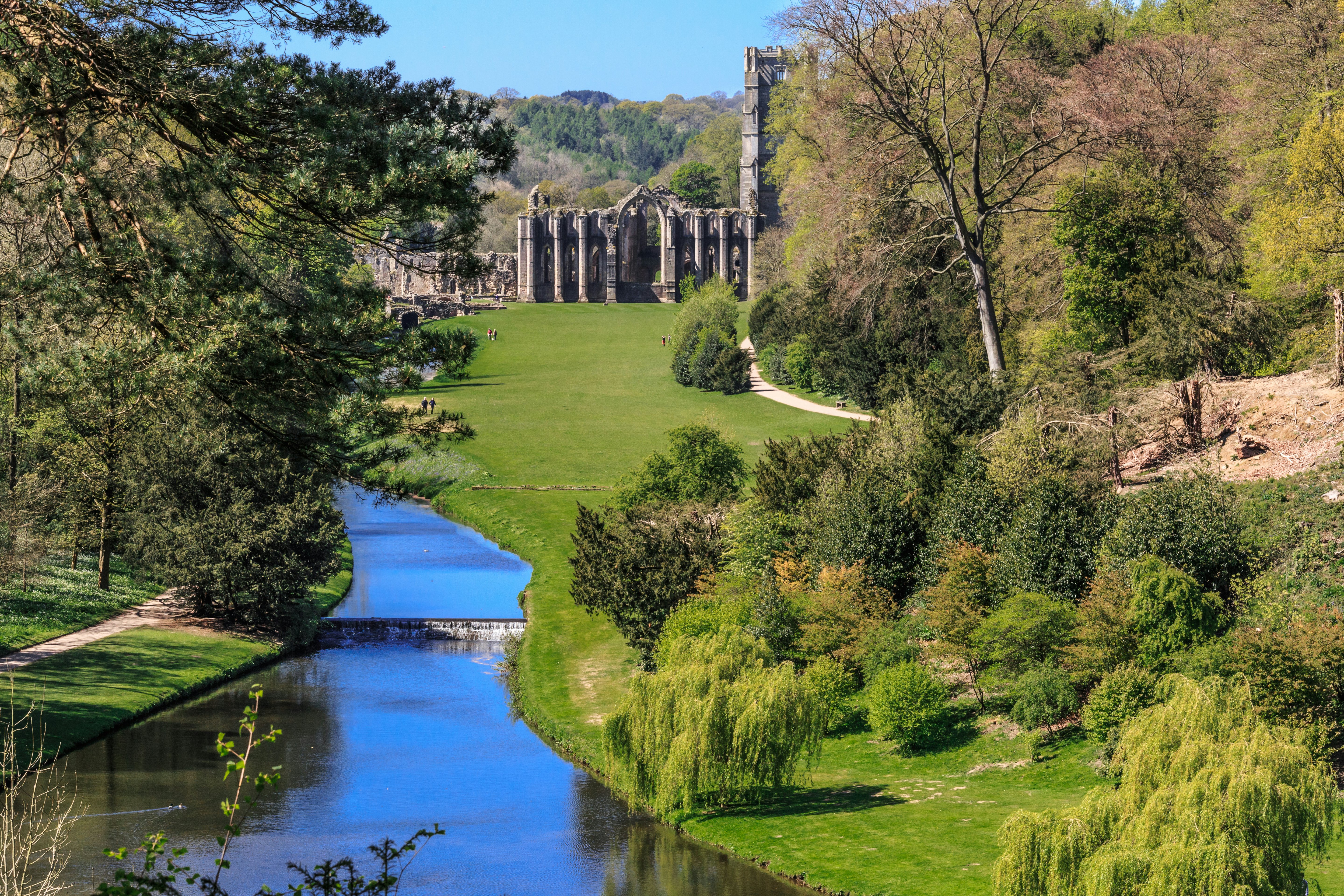The Lonely Planet guide to Yorkshire Dales National Park, England

Jul 18, 2025 • 12 min read

Yorkshire Dales National Park is a beautiful slice of the English countryside. Emily Marie Wilson/Shutterstock
Want to see rural England at its most bewitching? Head to the Yorkshire Dales, where glacial valleys are bisected by sparkling brooks, and sheep outnumber people in a landscape crisscrossed by walking paths and drystone walls.
Although less dramatic than the peaks and fells of the Lake District, the undulating hills of Yorkshire Dales National Park are no less beautiful, and the remote country pubs dotted around the hills are a delight at the end of a bracing walk. The national park stretches for 841 sq miles (218 sq km), and while the area is popular with hikers, cyclists, climbers and cavers, parts of the Dales still feel wonderfully off the radar.
The park’s busiest corners are the limestone escarpment at Malham Cove, and the village of Hawes in the center of the park, where the Wensleydale Creamery is based. But you could easily spend weeks here, strolling waterfall trails, climbing to windswept plateaus, scrambling through castle and abbey ruins, or drinking pints of ale in beer gardens with spectacular views.
Discover more with our guide to the best of Yorkshire Dales National Park.

What’s the history of Yorkshire Dales National Park?
Spilling over from the north of Yorkshire into Cumbria and Lancashire, Yorkshire Dales National Park was founded in 1954, and 97% of the land it covers is the property of local hill farmers, accessed via public footpaths. Rather than preserving untouched nature, the park protects a working landscape that has been used for sheep and cattle farming since at least the 12th century.
Hundreds of small working farms lie within the park boundaries, alongside tidy stone villages and towns that provide a home for some 20,000 people. But human habitation is widely dispersed, and the park still feels peacefully remote, despite the proximity of major urban centers such as Leeds, Harrogate and York.
By a quirk of local politics, Nidderdale near Harrogate in the southeast is designated separately as a National Landscape. In 2016, the national park boundaries were pushed westward into Lancashire and Westmorland, increasing the area of the park by 24%.
In 2020, the Yorkshire Dales were recognized as an International Dark Sky Reserve. Every year from February to March, the annual Dark Skies Festival features special stargazing trails, astronomy talks and nighttime activities in the park. There’s an associated Fringe Festival from October to November.
When should I visit Yorkshire Dales National Park?
The best time to visit Yorkshire Dales National Park mirrors the best time to visit other parts of England. The park sees the best weather for walking (and the biggest crowds) from June to September, when you can rely on mostly dry days. In late spring and early fall, trails are quieter, but the weather is still mostly mild.
By late October, the Dales start to feel damp and cool, with regular rain showers that give way to snow from December to February, creating challenging driving and walking conditions. Conversely, the cooler months can be the best time for stargazing, with long nights and many clear evenings.

Where should I stay in Yorkshire Dales National Park?
The Yorkshire Dales are popular with holidaying Britons, but there are few large-scale hotels, so most visitors camp or stay in B&Bs or rooms at country pubs. Demand can outstrip supply, especially in summer and over public holidays such as the spring bank holidays, so rooms should be booked well in advance.
What should I eat and drink on a trip to the Yorkshire Dales?
The Dales have a few local specialties to seek out. Aside from sampling the area’s famous crumbly Wensleydale cheese, set aside time for a slow Sunday pub lunch of Yorkshire lamb or local beef with crispy, puffy Yorkshire pudding. Look out on dessert menus for parkin, a traditional ginger cake made with oatmeal and black treacle.
In recent years, the Dales have become known for artisanal gins, whiskies and other spirits, thanks to the Yorkshire Dales Distillery in Colburn. Locally brewed beers are also popular; the town of Masham on the fringes of the park is the hub for breweries such as Theakstons and the Black Sheep Brewery.

What are the top experiences in Yorkshire Dales National Park?
From hill hikes to pub lunches, here are the best ways to enjoy Yorkshire Dales National Park.
Hike up Malham Cove
Despite the name, Malham Cove is actually an 80m-high (262.5ft-high) limestone cliff, formed by a huge glacial waterfall that gushed through some 12,000 years ago. Today, the amble through the fields from Malham village to the Cove (0.75 miles/1.2km) is one of Yorkshire’s most popular short walks.
Climbers follow sport and trad routes on sections of the cliff – except from May to September, when the Royal Society for the Protection of Birds (RSPB) sets up a bird-watching lookout to spot the peregrine falcons that nest in its nooks. Stairs on the left-hand side of the cliff lead up to the top of a vast limestone plateau for spectacular views (you may recognize the location from Harry Potter and the Deathly Hallows).
Ambitious hikers can take on the gorgeous 4.5-mile (7.2km), circular Malham Landscape Trail. From the top of the cove, the trail heads east to Gordale Scar, a narrow canyon with cascades and the remains of an Iron Age settlement, looping back via Janet’s Foss waterfall to end back in Malham village.
Extending the trail to loop around the boardwalks of marshy Malham Tarn – an internationally important nature reserve – bumps the outing up to an 11-mile (17.7km) hike. The Malham Dale website has trail maps and walking information.

Walk to a waterfall
Glacial activity in the last Ice Age created many sheer drop-offs for streams and rivers to tumble over. From tiny Hardraw, an easy 0.5-mile (0.8km) woodland trail leads to Hardraw Force, England’s highest single-drop waterfall, with a height of 30m (98ft). There’s a £4/US$5.40 admission fee.
Another appealing cascade is Aysgarth Falls near the village of of the same name. This low, triple-tiered waterfall on the River Ure has multiple free viewing points, some of which can be reached via accessible trails. With some care, it can be a lovely spot for a wild swim.
Near the village of Ingleton, the Ingleton Waterfalls Trail visits a string of spectacular waterfalls along the River Twiss and River Doe, including the dramatic Thornton Force, which drops 14m (46ft). The trail covers 4.5 miles (7.2km) in a circular loop, and there’s an £11 (US$15) entry fee.
Close to Malham, a 3-mile (4.8km) linear ramble will take you through shaded woodland to secluded Janet’s Foss, which spills into a tranquil pool. From the village of Grassington, it’s a short, five-minute stroll to Linton Falls, a thunderous, low falls on the River Wharfe.

Enjoy a pint with a view
The Yorkshire Dales are dotted with historic, stone-built, family-run country pubs that combine food, mood, real ales and a view, often with a crackling fire to warm your toes after a walk in the Dales. Start a pub tour at the historic Red Lion in Burnsall, where you can pair terrace views of the River Wharfe with a steak and Thwaites ale pie.
Over in Appletreewick, the 16th-century Craven Arms combines a cozy, wood-beamed, flagstone-floored interior with sweeping pastoral views outside. In Hudswell, the George & Dragon mixed dreamy vistas of Swaledale’s woodland with tasty rabbit pies. Meanwhile, the Bull Inn in West Tanfield has views over a 17th-century bridge crossing the River Ure from its beer garden.
Head northwest from Reeth to discover a beautiful pocket of the Dales that’s almost completely devoid of people. Yet here, almost an hour’s drive from the nearest town, lies the lonely Tan Hill Inn – Britain’s highest pub, at an elevation of 528m (1732ft).
Built to service the local mining community (who vacated the area in the 1920s), the pub today is a surprisingly hopping live-music destination on weekends, and a popular stop for hikers on the Pennine Way. If you’d like to stop over, there are en-suite bedrooms, a bunkhouse and a summer camping area.

Wander along the Dales Way
Running from Ilkley on the southern edge of the Dales to Bowness-on-Windermere in the Lake District, the 80-mile (129km) Dales Way follows rivers and broad valleys through some of the Dales’ most scenic countryside.
The section around Grassington is particularly pretty, and the town itself featured in 2020’s TV adaptation of All Creatures Great & Small, based on James Herriot’s popular veterinary tales.
Following the river south, the route passes Burnsall, a lovely stone village where picnickers launch dinghies and kayaks in summer, and the village of Appletreewick. About 6 miles (9.7km) south is atmospheric Bolton Abbey, with kid-friendly stepping stones, a river beach and plentiful walking trails alongside the ruins of an Augustinian priory.

Find the perfect Yorkshire roast
This is a great place to track down a hearty Yorkshire roast dinner. Pubs across the national park offer filling plates piled with local lamb, beef, pork or chicken, roast veggies, gravy and all the trimmings – including the almost mandatory Yorkshire pudding. The best time to enjoy a full roast is at lunchtime on Saturday or Sunday.
Locals rate the spread at the handsome stone Grassington House, where slow-cooked beef rump is the star of the show. In Carnforth, the characterful 17th-century Marton Arms near the Ingleton Waterfall Trail offers everything from roast pork with crackling to vegetarian bakes.
If you’re spending time in Malham, the Lister Arms is known for generous portions of roast meats, doused in homemade gravy, best enjoyed out in the beer garden. Over in Settle, you can feast on satisfying roasts by the stone fireplace in the Golden Lion, a 17th-century coaching inn that makes a great retreat after a Dales walk.

Go hiking around the Three Peaks in Ribblesdale
The national park’s southwestern skyline is dominated by a triangle of hills known as the Three Peaks, consisting of 694m (2277ft) Pen-y-ghent, 735m (2411ft) Whernside and 724m (2375ft) Ingleborough. Easily accessible via the Settle–Carlisle railway line, this is one of England’s most popular areas for hikers, hill cyclists and cavers.
The long-distance Pennine Way runs through here, but many hikers set their sights on the self-contained, 24-mile (38.6km) Yorkshire Three Peaks Challenge trail. The goal is to tackle all three peaks in under 12 hours, with a total ascent of 1585m (5200ft). It’s a tough undertaking, but highly rewarding.
The Settle–Carlisle line is also famous for the spectacular 30m-high Ribblehead Viaduct, near remote Ribblehead station. Completed in 1875, it spans 400m (1312ft) with 24 arches and it can be seen for miles around. Take in the views from the beer garden at the wood-beamed Station Inn.

Explore the caves of the Yorkshire Dales
Some 10 miles (16km) south of Ribblehead, the Ingleborough Estate Nature Trail leads to the Ingleborough Cave – an eroded cavern full of stalactites and stalagmites. You can explore on a self-guided trail for a fee, but guided tours for larger groups must be pre-arranged.
Nearby, across the park boundary in Nidderdale National Landscape, is Gaping Gill, one of Britain’s largest subterranean chambers. It’s open to the public twice a year (in late May and August) for Winch Meets run by the local Craven and Bradford caving clubs, when daredevils are lowered down the 100m-deep shaft to the chamber floor for a fee.
Close to the Grimwith Reservoir, the Stump Cross Caverns were discovered in 1860 by two lead miners, who opened up the caves to the public for a charge of one shilling. This is a show cave aimed at families, with geology information boards, fairy doors, fossil quizzes and ultraviolet illuminations after 3pm.
In upper Nidderdale, How Stean Gorge is a remote adventure center built around a spectacular cavern-dotted canyon fringed with moss and ferns. A camping field and wooden lodges lie within walking distance of the gorge. Kid-friendly activities range from cave exploring, via ferrata runs and gorge scrambling to kayaking at a nearby reservoir.

Follow the Farmhouse Cheese Trail
What do French monks have to do with Yorkshire cheese? The answer can be found at Jervaulx Abbey near Ripon, where Cistercian monks from Roquefort in France settled in 1156 CE, bringing the original recipe for Wensleydale cheese to England. Today, the privately owned abbey is an enchanting ruin (admission by honesty-box donation).
Propelled to global fame by cheese-obsessed Wallace from the famous Aardman Animations films, Wensleydale is still around today thanks to the Wensleydale Creamery in the lively village of Hawes, which has a cheese-making museum with live demonstrations, Wallace & Gromit photo opportunities and cheese tastings.
At the Creamery’s 1897 Coffee Shop, you can sample fruit cake with Wensleydale cheese – a Yorkshire tradition. Before leaving Hawes, drop by the Dales Countryside Museum, which takes a journey through local dairy farming, lead mining and the rise of the railways.
Traveling further west, visit the highly awarded Courtyard Dairy near Settle, where you can view the maturing room and sample before you buy (book ahead for cheesemaking classes). Marked by special events across the region, the Yorkshire Dales Cheese Festival in early October offers Yorkshire cheese nirvana.

Take a beer tour of Masham
The aromas of hops and malt have permeated the cobbled streets of Masham on the eastern edge of the Dales for almost two centuries. Theakston Brewery was founded here in 1827 and is still run by a descendant of the founder, Robert Theakston. Guided tours take visitors through the traditional, four-story brewing system, which still uses some of the original 19th-century equipment.
A five-minute walk down the road, tours at the Black Sheep Brewery reveal a more modern brewing process, and also explain why Paul Theakston – the “black sheep” of the Theakstons – ended up leaving the family brewery to establish his own brewing empire. After the tour, stop for a meal and ale at the beer-themed restaurant in a lofty barn conversion.
If you're up in the northern part of the Dales, pay a visit to the Yorkshire Dales Brewery in Askrigg, where you can sample the house ales and stouts at the attached beer tap and beer garden.

Detour to Fountains Abbey
Technically outside the park but easily reached by car are the UNESCO-listed ruins of Fountains Abbey and the water gardens of Studley Royal estate. This is perhaps the grandest relic from Henry VIII’s dissolution of the abbeys in the 16th century. Tours of the abbey and gardens run on weekends (free with admission ticket), and you can follow walking trails past temple follies, a medieval flour mill and historic St Mary’s Church.
Are the Yorkshire Dales accessible?
The national park has introduced some ambitious measures to make sure the Dales are accessible to all visitors, including special downloadable “Miles without Stiles” route guides for wheelchair users and parents with strollers. For the mobility impaired, special all-terrain electric buggies known as trampers are available for loan at popular sites such as Aysgarth Falls, Malham Tarn and Ingleborough Cave.
This article was adapted from Lonely Planet’s England guidebook, published in June 2025.



